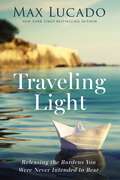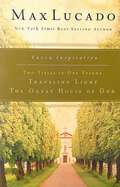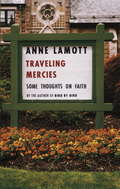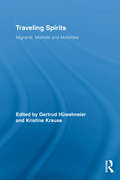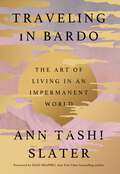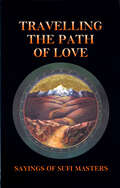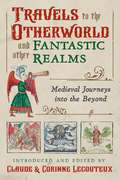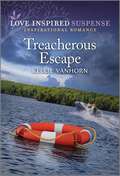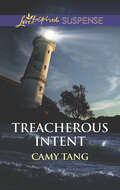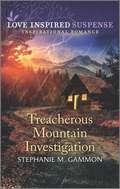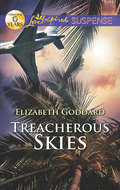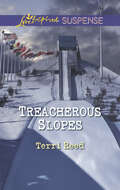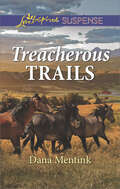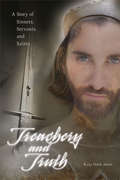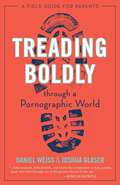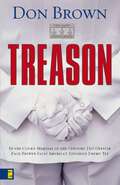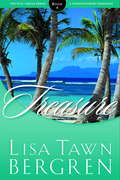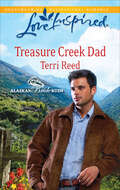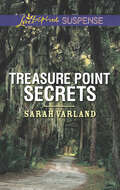- Table View
- List View
Traveling Light: Releasing the Burdens You Were Never Intended to Bear
by Max LucadoWeary travelers. You've seen them- everything they own crammed into their luggage. Staggering through terminals and hotel lobbies with overstuffed suitcases, trunks, duffels and backpacks. Backs ache. Feet burn. Eyelids droop. We've all seen people like that. At times, we are people like that-if not with our physical luggage, then at least with our spiritual load. We all lug loads we were never intended to carry. Fear. Worry. Discontent. No wonder we get so weary. We're worn out from carrying that excess baggage. Wouldn't it be nice to lose some of those bags? That's the invitation of Max Lucado. With the twenty-third Psalm as our guide, let's release some of the burdens we were never intended to bear.
Traveling Light: Releasing the Burdens You Were Never Intended to Bear
by Max LucadoWe're all weighed down by loads we were never intended to carry. With New York Times bestselling author and pastor Max Lucado as your guide, Traveling Light invites you to release some of those heavy burdens and experience true rest.We've all seen weary travelers—everything they own crammed into their luggage, staggering through terminals and hotel lobbies with overstuffed suitcases, trunks, duffels, and backpacks. Backs ache. Feet burn. Eyelids droop. We can all be people like that—if not with our physical luggage, then at least with our spiritual load of guilt, discontentment, doubt, or loneliness.Centered around the comforting, uplifting words of Psalm 23, Traveling Light will give you the encouragement and the tools you need to release the burdens of:Self-relianceArroganceHopelessnessDisappointmentShameThere are certain weights in life that we simply aren't designed to carry, and Max reminds us that the Lord is asking you to set them down and trust him. He is the father at the baggage claim. When a dad sees his five-year-old son trying to drag the family trunk off the carousel, what does he say? The father will say to his son what God is saying to you."Set it down, child. I'll carry that one."What if we took God up on his offer? We just might find ourselves traveling a little lighter.
Traveling Light: The Great House Of God (Day Brighteners Ser.)
by Max LucadoWeary travelers. You've seen them -- everything they own crammed into their luggage. Staggering through terminals and hotel lobbies with overstuffed suitcases, trunks, duffels, and backpacks. Backs ache. Feet burn. Eyelids droop. We've all seen people like that. At times, we are people like that -- if not with our physical luggage, then at least with our spiritual load. We all lug loads we were never intended to carry. Fear. Worry. Discontent. No wonder we get so weary. We're worn out from carrying that excess baggage. Wouldn't it be nice to lose some of those bags? That's the invitation of Max Lucado. With the Twenty-third Psalm as our guide, let's release some of the burdens we were never intended to bear. Using these verses as a guide, Max Lucado walks us through a helpful inventory of our burdens. May God use this Psalm to remind you to release the burdens you were never meant to bear.
Traveling Mercies: Some Thoughts on Faith (Americana Ser.)
by Anne LamottAnne Lamott claims the two best prayers she knows are: "Help me, help me, help me" and "Thank you, thank you, thank you." She has a friend whose morning prayer each day is "Whatever," and whose evening prayer is "Oh, well." Anne thinks of Jesus as "Casper the friendly savior" and describes God as "one crafty mother."Despite--or because of--her irreverence, faith is a natural subject for Anne Lamott. Since Operating Instructions and Bird by Bird, her fans have been waiting for her to write the book that explained how she came to the big-hearted, grateful, generous faith that she so often alluded to in her two earlier nonfiction books. The people in Anne Lamott's real life are like beloved characters in a favorite series for her readers--her friend Pammy, her son, Sam, and the many funny and wise folks who attend her church are all familiar. And Traveling Mercies is a welcome return to those lives, as well as an introduction to new companions Lamott treats with the same candor, insight, and tenderness. Lamott's faith isn't about easy answers, which is part of what endears her to believers as well as nonbelievers. Against all odds, she came to believe in God and then, even more miraculously, in herself. As she puts it, "My coming to faith did not start with a leap but rather a series of staggers." At once tough, personal, affectionate, wise, and very funny, Traveling Mercies tells in exuberant detail how Anne Lamott learned to shine the light of faith on the darkest part of ordinary life, exposing surprising pockets of meaning and hope.From the Trade Paperback edition.
Traveling Solo, but Never Alone: Surviving and Thriving After the Death of a Spouse
by Bill HarrisonWhen my wife passed away four days before Christmas in 2017 I was devastated. Mary and I had a challenging, exciting and adventurous life together for over 53 years, traveling the globe and finding success in a number of careers. But suddenly she was gone. I had lost my identity and purpose. I cried out: “What now, Lord?” “Why am I still here?” “What do you have in store for me now?” And over the ensuing months God began to show me that, although my role had drastically changed, my identity as his child remained the same and that he still had a purpose in my being here, which he began to reveal to me. And he reassured me, though I was now traveling solo, I would never be alone. This book is the story of my journey since Mary’s passing and what I have learned from my experiences. I hope it will be a source of inspiration for those who have experienced great loss, encouraging them with the knowledge that God is not finished with them, but has much more for them to learn, experience and accomplish. To follow my continuing journey see my blogs at https://spiritual-entrepreneurship.com/blog-posta/ Finally, Enjoy Spiritual Entrepreneurship: Fulfilling Your God-Ordained Destiny By Bill and Mary Harrison Available Wherever You Buy Your Books
Traveling Spirits: Migrants, Markets and Mobilities (Routledge Studies in Anthropology)
by Gertrud Hüwelmeier Kristine KrauseMaintaining and forging religious networks across borders have long been part of migrants' activities. However, due to the wide availability of communication technologies and the reduced costs of transportation, transnational social practices, including religious activities, have witnessed an enormous intensification in the last few decades around the world. Traveling Spirits seeks to understand these processes by investigating how religion goes global. How do religious agents create and maintain transborder connections? In what way are religious practices being transformed, reinforced or newly invented when transported to different places around the world? How are power relations negotiated within transnational religious networks? How are processes of coming and going linked to religious practices and discourses? The book’s contributors provide rich ethnographic case studies on mobile evangelists, moving spirit mediums, and traveling believers. They analyze the relationship between global, regional, national, local and individual religious processes by centering on economic activities, media representations, or politics of emplacement. Grounded firmly in cross-cultural comparison, this book contributes significantly to the literature on globalization, migration and transnational religion.
Traveling in Bardo: The Art of Living in an Impermanent World
by Ann Tashi SlaterA luminous guide to navigating transition and impermanence rooted in the Tibetan Buddhist tradition of bardo. In a world where nothing lasts forever, how do we live? Life is perpetually, endlessly filled with change: new jobs and new loves, unfamiliar places and faces. And entwined in that change is loss: loss of what was or is, or what could have been. In the midst of this shifting landscape, Traveling in Bardo invites us to embrace impermanence in a powerful way, rooted in ancient wisdom. Interweaving explorations of bardo in relation to marriage and friendship, parents and children, work and creativity with stories of her Tibetan ancestors and the Buddhist teachings on the fleeting nature of existence, Ann Tashi Slater illuminates what the teachings have to tell us in our contemporary lives. She relays vital wisdom from Tibetan culture, giving us a bold, new framework to navigate moments of change and live life fully. During over forty years of writing and speaking about her Tibetan-American heritage and the relevance of Buddhism in Western society, Slater has come to see how Tibetan bardo views on impermanence can transform the way we live. In Tibetan belief, bardo is the interval between death and rebirth, as well as the intermediate state between birth and death. It also refers to liminal periods in life when the reality we know comes to an end. A time of great possibility, it offers us the opportunity to find happiness in an impermanent world.
Travelling the Path of Love: Sayings of Sufi Masters
by Llewellyn Vaughan-LeeWith the passion and depth of feeling that belong to lovers, Sufi masters through the centuries have described the soul's journey toward union with God. This collection of sayings, dating from the ninth century to the present day, follows the stages of the journey, allowing the masters to beckon us along this ancient path.
Travels in a Stone Canoe: The Return to the Wisdomkeepers
by Harvey Arden Steve WallFrom the book: This journey of ours, then, is a journey into metaphor, into meaning, into human subjectivity, into the belief systems of others and of ourselves, into the very meaning of belief itself. And yet, despite its inward aspects, this spirit-journey is and has been absolutely real, filled with rented cars and cheap motels and fast-food restaurants and shopping malls and interstate highways, and-most significant to us-with out-of-the-way dirt roads leading to the always open doors of those we call Wisdomkeepers, the spiritual elders of Native America. These wonderful men and women don't simply preserve the old wisdom. They live it. And, yes, they share it and teach it, too-not only with their words but with their example, their presence, their lives . . . lives always lived for others, never for themselves. We are not, definitely not, experts on Indians. We aren't scholars or anthropologists or historians; we're not even journalists anymore. Yet our journey, our spirit-journey is inexorably ongoing. Whenever we think it's finally over and done with, we somehow find ourselves swept back into it once again despite ourselves, flung back onto the road, into the current, back on the path of the Wisdomkeepers. But don't mistake it for an easy path. Life, we've learned from the Wisdomkeepers, is not an entertainment. Life is a task, a holy task. There's a path you follow, and there's a set of Original Instructions for following that path. Our journey, our life's work, has been an unfolding of those Instructions, which-as Wisdomkeeper Uncle Frank Davis showed us-lie within our souls like shredded, crumpled pieces of paper, hieroglyphed with the meanings of life, our own personal life in particular.
Travels to the Otherworld and Other Fantastic Realms: Medieval Journeys into the Beyond
by Claude and Corinne LecouteuxA collection of tales from the Middle Ages that reveal voyages to Heaven and Hell, the realm of the Faery, mystical lands, and encounters with mythic beasts • Shares travelers&’ accounts of voyages into the afterlife, alarming creatures of unparalleled strangeness, encounters with doppelgangers and angels, chivalric romantic misadventures, and legends of heroes • Explains how travelers&’ tales from the Middle Ages drew on geographies, encyclopedias, travel accounts, bestiaries, and herbals for material to capture the imagination of their audiences • Includes rare illustrations from incunabula and medieval manuscripts Heading off to discover unknown lands was always a risky undertaking during the Middle Ages due to the countless dangers lying in wait for the traveler--if we can believe what the written accounts tell us. In the medieval age of intercontinental exploration, tales of sea monsters, strange hybrid beasts, trickster faeries, accidental trips to the afterlife, and peoples as fantastic and dangerous as the lands they inhabited abounded. In this curated collection of medieval travelers&’ tales, editors Claude and Corinne Lecouteux explain how the Middle Ages were a melting pot of narrative traditions from the four corners of the then-known world. Tales from this period often drew on geographies, encyclopedias, travel accounts, bestiaries, and herbals for material to capture the imagination of their audiences, who were fascinated by the wonders being discovered by explorers of the time. Accompanied by rare illustrations from incunabula and medieval manuscripts, the stories in this collection include voyages into the afterlife, with guided tours of Hell and glimpses of Heaven, as well as journeys into other fantastic realms, such as the pagan land of the Faery. It also includes accounts from travelers such as Alexander the Great of alarming creatures of unparalleled strangeness, encounters with doppelgangers and angels, legends of heroes, and tales of chivalric romantic misadventures, with protagonists swept to exotic new places by fate or by quest. In each story, the marvelous is omnipresent, and each portrays the reactions of the protagonist when faced with the unknown. Offering an introduction to the medieval imaginings of a wondrous universe, these tales reflect the dreams and beliefs of the Middle Ages&’ era of discovery and allow readers to survey mythic geography, meet people from the far ends of the earth, and experience the supernatural.
Treacherous Escape
by Kellie VanHornFramed for murder… with the real criminals in pursuit. A groundbreaking discovery catapults biochemist Vienna Clayton into a world of danger when her laptop is stolen and her boss is murdered. Vienna flees onto stormy Lake Superior—only to be rescued by park ranger Hudson Lawrence. She's framed for crimes she didn&’t commit, and they&’re determined to clear her name, but with the clock ticking down, it&’s the threats they can&’t see coming that could cost them their lives…From Love Inspired Suspense: Courage. Danger. Faith.
Treacherous Intent: The Yuletide Rescue Navy Seal Noel Treacherous Intent (The Sonoma Series)
by Camy TangDANGER AT HER DOORSTEP Private investigator Elisabeth Aday thinks her California women's shelter is a safe haven-until skip tracer Liam O'Neill shows up. While searching for a missing woman, Liam unwittingly puts Elisabeth in the crosshairs of the deadly drug gang that is trailing his target. To stay alive, they must find the woman before the gang finds them. And when a second rival gang joins the search, the threats multiply. Deep in the lair of notorious drug dealers, Elisabeth can't tell which is more dangerous-the criminals after her...or her growing feelings for the man at her side.
Treacherous Mountain Investigation
by Stephanie M. GammonA journalist’s job could get her killed…Years ago, Elizabeth Hart took down a human trafficking ring in the Rocky Mountains with a single blog post—and now someone wants revenge. But her ex-fiancé, Officer Riggen Price, won’t let anyone hurt her or his newly discovered son. With the threats only escalating, can Liz trust the man who broke her heart…and live to give their family a second chance?
Treacherous Skies
by Elizabeth GoddardAfter years of peace and quiet, Maya Carpenter thinks she's safe-that her drug-lord father's world will never catch up with her. Then she's abducted and secretly stashed on a plane. And once she and the test pilot who finds her land in the Keys, the real threat begins....Daredevil pilot Connor Jacobson is no one's hero. And this time, he's in way over his head. Yet he can't leave Maya to face danger alone. Besides, he has a few tricks up his sleeve that might keep them safe...as long as he's willing to put everything at risk, including his heart.
Treacherous Slopes
by Terri ReedKILLER COMPETITION A champion ski jumper, Nick Walsh wants one thing: to win the gold for his late brother. Nick has always blamed himself for his family's tragic loss-and so does everyone else. To complicate things, sweet and shy reporter Julie Frost insists on doing a story about him. But as Nick gets closer to achieving his dream, someone will do anything to stop him. Somehow, Nick must keep Julie from getting too close as they confront a threat that can destroy them both. Julie and Nick are on the verge of discovering the truth about his brother's death...unless an unknown murderer finds them first.
Treacherous Trails: Night Stalker Treacherous Trails Secret Service Setup (Gold Country Cowboys #2)
by Dana MentinkA woman falsely accused becomes the real killer’s next target in this jaw-dropping, suspense-filled romance from the USA Today–bestselling author.In this Gold Country Cowboys story, farrier Ella Cahill is accused of murder—and only former marine Owen Thorn, her brother’s best friend, can help clear her name. Now with someone trying to kill Ella, Owen must protect her . . . despite his promise to her brother to stay away from her. But can they work together to find the true killer before she becomes the next to die?
Treachery and Truth
by Katy Huth JonesImmersed in the historical background of the tenth century, this true tale of Good King Wenceslas, as told by his faithful servant Poidevin, brings the reader into the Dark Ages. Fear grips the land of Bohemia as the faithful face betrayal and persecution under the reign of the pagan Duchess Dragomira. As she struggles for power with the rightful heir, Prince Václav, her foes forge alliances in secret despite the risk of discovery. Who will survive?
Tread Upon the Lion (Liberty Bell, #3)
by Gilbert MorrisBook 3 in The Liberty Bell series. Daniel Bradford's fight to save his son is threatened when Sir Leo Rochester hires Abigail Howland of the Winslow family to lure Matthew into his evil schemes.
Treading Boldly through a Pornographic World: A Field Guide for Parents
by Daniel Weiss Joshua GlaserParents today are the first generation to raise kids in a digitally connected, porn-saturated world. Porn can be accessed in locker rooms, cafeterias, classrooms, and bedrooms—anywhere kids have access to digital devices. Worse yet, pornography that was once considered fringe has become increasingly mainstream. All this is misshaping children&’s understanding of sexuality, stunting their capacity to process emotions, and crippling their ability to form long-term relationships. In Treading Boldly through a Pornographic World, Daniel Weiss and Joshua Glaser offer practical and spiritual guidance for parents seeking to help their teens navigate this pornographic digital landscape. Combining the latest research with personal and professional experience to guide families into the goodness for which God created us all, the authors skillfully outline the steps necessary for parents to move beyond merely surviving pornography&’s challenges onto a rewarding path where their children can truly thrive.
Treason (The Navy Justice Series #1)
by Don BrownThe stakes are high . . . and the entire world is waiting for the verdict. The Navy has uncovered a group of radical Islamic clerics who have infiltrated the Navy Chaplain Corps, inciting sailors and marines to acts of terrorism. And Lieutenant Zack Brewer has been chosen to prosecute them for treason and murder. Only three years out of law school, Zack has already made a name for himself, winning the coveted Navy Commendation medal. Just coming off a high-profile win, this case will challenge the very core of Zack's skills and his Christian beliefs-beliefs that could cost him the case and his career. With Diane Colcernian, his staunchest rival, as assistant prosecutor, Zack takes on internationally acclaimed criminal defense lawyer Wells Levinson. And when Zack and Diane finally agree to put aside their animosity, it causes more problems than they realize.
Treasure (Full Circle #4)
by Lisa Tawn BergrenA dangerous search for an ancient ship leads to a heart's treasure beyond price. <P> Ever since her days as an undergrad student at Harvard, where she roomed with Bryn Bailey (Pathways)--nautical archaeologist Dr. Christina Alvarez has been obsessed with finding her ancestor's sunken treasure ship and striking underwater gold. Determined to achieve her goal, Christina has traveled to the Caribbean island of Robert's Foe, where treasure hunter Mitch Crawford--the one man who can assist her--refuses to help. But Christina's fight to win Mitch over may lead them both to a Treasure more valuable than either one of them ever dreamed.
Treasure Creek Dad (Alaskan Bride Rush #2)
by Terri ReedSingle father Jake Rodgers's daughter isn't happy about moving to tiny Treasure Creek, Alaska. So the former big-city businessman trades his suits for hiking boots and he books a father-daughter wilderness tour to acclimate her. But Veronica isn't buying it. Perhaps guide Casey Donner is just the person to help the girl appreciate the Klondike state's natural beauty. But could tomboy Casey, in her ponytail and cargo pants, also be what this city boy needs for a lifetime of love?
Treasure Daily Readings: A Four-Week Study on Faith and Money (Treasure)
by Jacob ArmstrongWhether you are in plenty or in want, money has a direct connection to your values, your faith, and the health of your relationships. It’s no wonder that in the Sermon on the Mount, Jesus presented a radical message about our "treasure" and our hearts. In this four-week study, Jacob Armstrong uses Matthew 6 to reexamine how we look at our finances and possessions, through the counter-cultural teachings of the Sermon on the Mount. Sessions include:Week 1: Where Is Your Treasure? Matthew 6:19-23Week 2: The Problem with Two Masters Matthew 6:24Week 3: How to Give Matthew 6:1-6Week 4: Don’t Worry ‘Bout a Thing Matthew 6:25-35 This book of daily devotional readings is an important part of the program and is designed both for individual reading and group use. The book helps participants explore ways in which generosity and financial challenges in their personal lives can affect relationships with people and with God. Each devotion includes a Scripture, a short reading with stories, and a prayer.This Daily Readings book and DVD can be used in a small group setting or with the Program Guide and Flash Drive as part of a church-wide Stewardship program.
Treasure Point Secrets: Bodyguard Reunion Grave Danger Treasure Point Secrets
by Sarah VarlandPERILOUS PURSUIT It's been five years since Shiloh Evans encountered the murderous gold hunters seeking Blackbeard's hidden stash. After they killed her policewoman cousin, Shiloh left town to regroup, and earn her own police badge. Because she would see this case solved-someday. She just didn't expect the killers to attack her new home in Treasure Point, Georgia...on the same day her ex-fiancé arrived in town. Adam Cole has tried to overcome his love for Shiloh. But he won't just sit by when she's in danger. Working together, they plan a trap. But springing it requires getting to centuries-buried treasure before the killers get to them.

